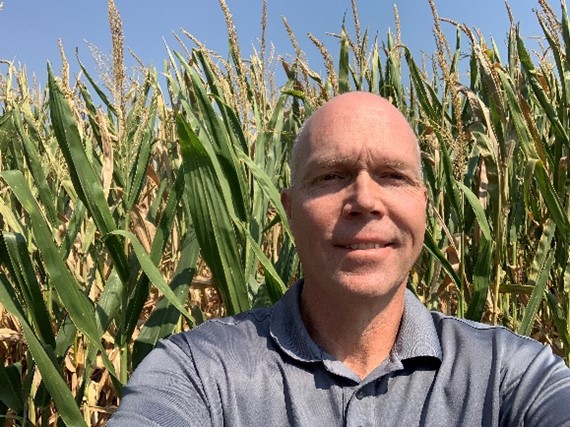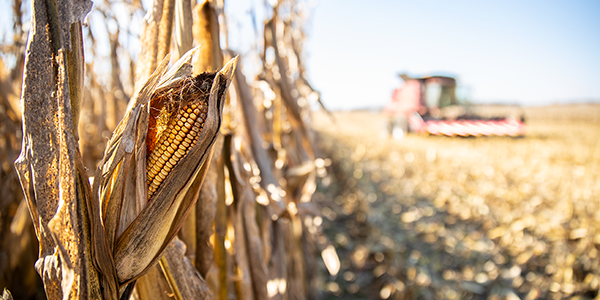AGRONOMICSUPPORT
YOU CAN TAKETO THE FIELD
Get ready for harvest with these scouting tips
Scouting fields ahead of harvest helps farmers avoid the hassle and slowdown associated with downed corn. “Avoiding those issues limits time in the field, saving fuel, time and labor,” says Justin Schneider, an LG Seeds agronomist in Michigan.

“Prioritizing harvest and early identification of fields that could have issues is only a benefit,” Schneider says. And high natural gas prices in 2022 mean farmers don’t want to dry any more corn than necessary. “The best way to leave your corn out there in the field the longest is to scout,” Schneider observes.
The potential is certainly there for stalk issues in Michigan and other areas of the country that have dealt with heat and dryness. That includes dryland and irrigated corn farmers in Nebraska who withstood a blustery spring followed by summer heat and dryness, says Mark Grundmayer, an agronomist with LG Seeds in the state. He says hot nights during pollination and 90-degree temperatures as the calendar flipped to September won’t help the situation.
Start scouting now and keep at it
Late August or early September is a great time to start scouting fields for potential harvest issues, the agronomists say. After establishing a baseline, farmers should check fields every week to 10 days. “And then once we hit black layer, get out there and assess to prioritize fields for harvest and be as efficient as possible,” Schneider recommends.
“If you are in a drought, plants start to cannibalize themselves from the ground up a bit earlier,” Schneider warns. “Those farmers will likely be dealing with some stalk lodging issues.”
“Under any kind of stress, whether that’s stalk rot, green snap, a late hailstorm or disease-causing loss of the leaf area, we want to get as much harvested while it’s still standing as possible. That might mean an early harvest,” Grundmayer says.
Corn tends to have the most stalk lodging issues once it dries to the low 20s or high teens, according to Schneider. “If you see some problematic-looking fields, consider harvesting when moisture is in the mid-20s.”
Evaluate stalk integrity with a push or pinch test
A push or pinch test can help identify problem fields. Schneider explains the push test as follows:
“Once you hit black layer, walk through your cornfields, stand next to the cornstalk and push it an arm’s length away. When you let go, you hope it comes back and hits you in the nose. If it kinks, breaks or falls over, assess what percent is doing that. If it’s 5% to 10% of the plants, you may need to harvest that field sooner than others.”
With the pinch test, Schneider explains a farmer simply pinches the cornstalk from chin-high down to the bottom couple of nodes on the cornstalk. “If you’re able to pinch it together with ease, that’s telling you the stalk is hollow inside. If threatening weather (e.g., high winds or heavy rain) is forecast, you may want to get out there and harvest that grain a bit wetter than you normally would.”
Besides prioritizing fields and possibly moving up harvest, farmers with downed corn should adjust the combine so it picks up all that it possibly can, in addition to making changes to account for a smaller kernel size caused by drought. “There’s a lot of money on the line, so you don’t want anything riding out the back,” Schneider says, adding that farmers should go slow in fields with lodging.
“A ground speed of 2 mph is usually adequate for harvesting lodged corn. By harvesting at a slower speed, your ability to pick up lodged ears that would otherwise be missed will increase. Gathering-chain speeds and snapping-roll velocity should be correspondingly reduced to maintain the normal relationship with ground speed,” details an Agronomy Guide from Purdue University Cooperative Extension Service. When lodging is especially severe, farmers should consider harvesting against the direction of the lodging.
If a field has a lot of lodging issues, farmers should also be aware of the threat of volunteer corn the following season and adjust rotation and herbicide plans accordingly, he adds.
Crop rotation is especially important for disease control when you are practicing some form of reduced tillage since pathogens can overwinter in organic debris and infect corn the following year for corn-on-corn acres, according to the Agronomy Guide.
Review and improve

The reasons for scouting your corn crop late in the season go well beyond harvest. “Late-season scouting is like watching game film,” Grundmayer says. “It gives you a chance to evaluate things like your fertility program, fungicide decisions, hybrid selection and weed control. You can assess what went well and where changes are needed.”
When it comes to selections for 2023, Grundmayer says farmers in the West will focus on which products handled stress well, noting there isn’t a lot of disease in his area due to the hot, dry season. “Ultimately, it’s going to come back to stalk quality and whether or not a hybrid was able to handle stress.”
A hybrid that stood out to Grundmayer was LG5700. He explains it “has maintained good plant health and stalk quality, despite heat and dryness.”
“Whether or not you’re using our products, LG Seeds agronomists are here to help you evaluate your hybrids and crops,” Schneider says. “Assess your game plan and let’s figure out how we can improve on that going forward.”
Stay safe as harvest gets underway
As harvest picks up, the agronomists urge farmers to take their time and exercise caution. “Farmers are putting in a lot of long days and dealing with some added stress during harvest,” Grundmayer says. “Take a break if you need one. Stay safe.”





